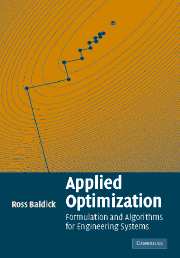Book contents
- Frontmatter
- Contents
- List of illustrations
- Preface
- 1 Introduction
- 2 Problems, algorithms, and solutions
- 3 Transformation of problems
- Part I Linear simultaneous equations
- Part II Non-linear simultaneous equations
- 6 Case studies
- 7 Algorithms
- 8 Solution of the case studies
- Part III Unconstrained optimization
- Part IV Equality-constrained optimization
- Part V Inequality-constrained optimization
- References
- Index
6 - Case studies
Published online by Cambridge University Press: 03 December 2009
- Frontmatter
- Contents
- List of illustrations
- Preface
- 1 Introduction
- 2 Problems, algorithms, and solutions
- 3 Transformation of problems
- Part I Linear simultaneous equations
- Part II Non-linear simultaneous equations
- 6 Case studies
- 7 Algorithms
- 8 Solution of the case studies
- Part III Unconstrained optimization
- Part IV Equality-constrained optimization
- Part V Inequality-constrained optimization
- References
- Index
Summary
In this chapter, we will develop two case studies of problems that involve the solution of non-linear simultaneous equations. Both case studies will involve circuits, but the non-linearities will arise in different ways. The case studies are:
the solution of Kirchhoff's laws in a non-linear direct current (DC) circuit (Section 6.1), and
the solution of Kirchhoff's laws in a linear alternating current (AC) circuit where the variables of interest are not currents and voltages but instead are power (and “reactive power”) injections (Section 6.2).
The first case study will draw on the development from the linear circuit study described in Section 4.1 and we will not repeat in detail those issues that were already presented in Section 4.1. The second case study will be discussed in considerable detail.
The progression from the case study of Section 4.1 to the case studies of Sections 6.1 and 6.2 are examples of model extension and development. By developing the model incrementally, we can treat a few issues at a time without being overwhelmed by trying to analyze all the issues at once. In developing your own models, you might also build them step-wise, rather than all-at-once. Even an unrealistically simple initial model can provide valuable insights into more realistic cases. For example, most DC circuits in practice include at least some non-linear components. Nevertheless, formulation of the linear DC circuit case study in Section 4.1 has provided most of what we need to formulate a non-linear DC circuit case study.
- Type
- Chapter
- Information
- Applied OptimizationFormulation and Algorithms for Engineering Systems, pp. 259 - 284Publisher: Cambridge University PressPrint publication year: 2006

